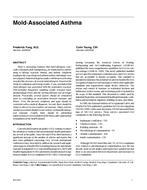Description
There is increasing evidence that mold allergens, especially Alternaria and Cladosporium, are implicated in contributing to allergic reaction, rhinitis, and asthma. Situations leading to the exacerbation of asthma in three individuals were investigated. Industrial hygiene studies with bioaerosol testing revealed the presence of several mold allergens. Based on the medical evaluation and testing results, it was concluded that mold allergen was associated with the respiratory reaction. Post-remedial bioaerosol sampling results revealed background fungal levels and the inciting allergen was no longer present. Practically, several factors should be considered prior to concluding an association between exposure and illness. First, the person’s symptoms and signs should be consistent with a medical diagnosis. Second, there should be either in vitro or in vivo evidence of exposure. Third, environmental assessment should reveal evidence of plausible biological exposure. Fourth, there should be substantial improvement or even resolution of the illness after appropriate remediation of the health hazard.
Authors:Frederick Fung, M.D., Colin Young, CIH
Citation:Indoor Air Quality 2001: Moisture, Microbes, and Heath Effects: Indoor Air Quality and Moisture in Buildings Conference Papers
Keywords:November, 2001, California
Citation: IAQ Conference: IAQ 2001
Product Details
- Published:
- 2001
- File Size:
- 1 file , 68 KB
- Product Code(s):
- D-8148




